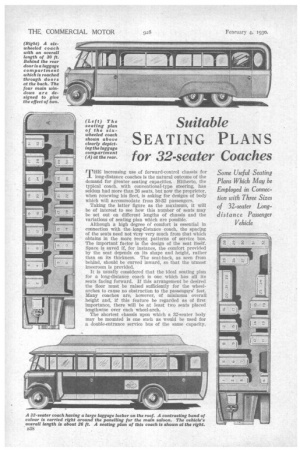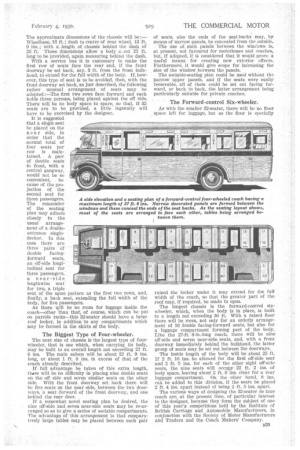Suitable SEATING PLANS for 32-seater Coaches
Page 64

Page 65

If you've noticed an error in this article please click here to report it so we can fix it.
Some Useful Seating Plans Which May be Employed in Connection with Three Sizes of 32-seater Longdistance Passenger Vehicle
rrHE increasing use of forward-control chassis for -L long-distance coaches is the natural outcome of the demand for greater seating capacities. Hitherto, the typical coach, with conventional-type steering, has seldom had more than 26 seats, but now the proprietor, when renewing his fleet, is asking for designs of body which will accommodate from 30-32 passengers.
Taking the latter figure as the maximum, it will be of interest to see how this number of seats may be set out on different lengths of chassis and the variations of seating plan which /are possible.
Although a high degree of comfort is essential in connection with the long-distance coach, the spacipg of the seats need not iizry very much from that Which obtains in the more recent patterns of service bus. The important factor is (he design of the seat itself. Space is saved if, for instance, the comfort provided by the Seat depends on its shape and height, rather than an its thickness. The seat-back, as seen from behind, should be curved inward, so that the utmost kneeroom is provided.
It is usually considered that the ideal seating plan for a long-distance coach is one which has all its seats facing forward. If this arrangement be desired the floor must be raised sufficiently for the wheelarches to cause no obstruction to the passengers' feet. Many coaches are, however, of minimum overall height and, if this feature •be regarded as of first importance, there will be at least two seats placed lengthwise over each wheel-arch.
The shortest chassis upon which a 32-seater body may be mounted is one such as would be used for a double-entrance service bus of the same capacity. The approximate dimensions Of the chassis will be:— Wheelbase, 16 ft. dash to centre of rear 'wheel, 13 ft.. 9 ins.; with a length of chassis behind the dash of 20 ft. These dimensions allow a body about 21 ft. long to be provided, again measuring behind the dash.
With a service bus it is customary to make the first row of seats • fate the rear and, if the front doorway be set back, say, 3 ft. from the front bulkhead, to extend for the full width of the body. If, however, this type of seat is to be avoided, then, with the front doorway set back, as just described, the following rather unusual arrangement of seats may be adopted:—The first two rows face forward and each holds three persons, being placed against the off side. There Will be no body space to spare, so that, if 32 seats are to be provided, a little ingenuity will have to be exercised by the designer.
It is suggested that a single seat be placed on the near side, in order that the normal total of four seats per row is maintained. A pair of double seats in front, with a central gangway, would not be so convenient, be cause of the projection of the second seat for three passengers. The remainder of the seating plan may adhere closely to the usual arrangement of a doubleentrance singledecker. In this case there • are three pairs of double fa,cingforWard seats, an off-side longitudinal seat for three passengers, a near-side lengthwise seat for two, a triple seat of the same pattern as the first two rows, and, finally, a back seat, extending the full width of the body, for five passengers. As there will be no room for luggage inside the coach—other than that, of course, which can be put on parcels racks—this 32-seater should have a large roof locker, in addition to any compartments which may be formed in the skirts of the body.
The Biggest Type of Four-wheeler.
The next size of chassis is the largest type of fourwheeler, that is one which, when carrying its body, May be built to an overall length not exceeding 27 ft.
ins. The main saloon will be about 22 ft. 9 ins. long, or about 1 ft. 9 ins, in excess of that of the coach already described.
If full advantage be taken of this extra length, th.re will be no difficulty in placing nine double seats on the off side and seven similar seats on the other side. With the front doorway set back there will be five seats on the near side, between the two doorways, a seat forward of the front doorway, and one behind the rear door.
If a somewhat novel seating plan he desired, the nine off-side and seven near-side seats may be re-arranged so as to give a series of sociable compartments. The advantage of this arrangement is that comparatively large tables may be placed between each pair of seats, also the ends of the seat-hacks may, by means of narrow panels, be concealed from the outside.
The use of. such panels' between the windows is, at present, not favoured for motorbuses and coaches, but, if adopted, it is considered that it would prove a useful means for creating new exterior effects. Flartherrnore, it would give scope for increasing the size of the window between the panels.
The sociable-seating plan could be used without the narrow upper panels, and if the seats were easily removable, all of them could be set out facing forward, or back to back, the latter arrangement being particularly suitable for private coaches.
" The Forward-control Six-wheeler.
As with the smaller 32-seater, there will be no floor space left for luggage, but as the floor is specially raised the locker under it may extend for the full width of the coach, so that the greater part of the roof may, if required, be made to open. The longest chassis is the forward-control sixwheeler, which, when the body is in place, is built to a length not exceeding 30 ft. With a raised floor there will be room, not only for an orderly arrangement of 16 double facing-forward seats, but also for a luggage compartment forming part of the body. Like the 27-ft. 6-in.-long coach, there will be nine off-side and seven nearside, seats, and, with a front doorway immediately behind the bulkhead, the latter group of seats may be set out between the doorways. The inside length of the body will be about 25 ft. If 2 ft. 10 ins, be allowed for the first off-side seat and 2 ft. 5 ins, for each of the other eight off-side • seats, the nine seats will occupy22 ft. 2 ins, of body space, leaving about 2 ft. 6 ins, clear for a rear luggage compartment. On the other hand, 8 ins, can be added to this division, if the seats be placed 2 ft. 4 ins, apart instead of being 2 ft. 5 ins. apart.
The various ways of designing the 32-seater de luxe coach are, at the present time, of particular interest to the designer, because they, form the subject of one of this year's competitions held by the Institute of British Carriage and Automobile Manufacturers, in conjunction with the Society of Motor Manufacturers and Traders and the Coach Makers' Company.




















































































































